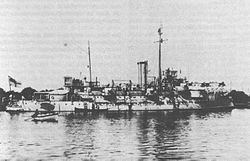Name Frithjof Laid down February 1890 Construction started February 1890 Length 79 m Displacement 3.5 million kg | Namesake Frithjof Commissioned 23 February 1893 Launched 21 July 1891 Weight 3,500 tons | |
 | ||
Fate Rebuilt as merchant ship, 1923; scrapped at Danzig, 1930 Class and type Siegfried-class coast defense ship | ||
SMS Frithjof was the third vessel of the six-member Siegfried class of coastal defense ships (Küstenpanzerschiffe) built for the German Imperial Navy. Her sister ships were Siegfried, Beowulf, Heimdall, Hildebrand, and Hagen. Frithjof was built by the AG Weser shipyard between 1890 and 1893, and was armed with a main battery of three 24-centimeter (9.4 in) guns. She served in the German fleet throughout the 1890s and was rebuilt in 1900 - 1902. She served in the VI Battle Squadron after the outbreak of World War I in August 1914, but saw no action. Frithjof was demobilized in 1915 and used as a barracks ship thereafter. She was rebuilt as a merchant ship in 1923 and served in this capacity until she was broken up for scrap in 1930.
Contents
Design
Frithjof was 79 meters (259 ft) long overall and had a beam of 14.90 m (48.9 ft) and a maximum draft of 5.74 m (18.8 ft). She displaced 3,741 long tons (3,801 t) at full combat load. Her propulsion system consisted of two vertical 3-cylinder triple expansion engines. Steam for the engines was provided by four coal-fired boilers. The ship's propulsion system provided a top speed of 15 knots (28 km/h; 17 mph) and a range of approximately 1,490 nautical miles (2,760 km; 1,710 mi) at 10 knots (19 km/h; 12 mph). Frithjof had a crew of 20 officers and 256 enlisted men.
The ship was armed with three 24 cm K L/35 guns mounted in three single gun turrets. Two were placed side by side forward, and the third was located aft of the main superstructure. They were supplied with a total of 204 rounds of ammunition. The ship was also equipped with eight 8.8 cm SK L/30 guns in single mounts. Frithjof also carried four 35 cm (14 in) torpedo tubes, all in swivel mounts on the deck. One was at the bow, another at the stern, and two amidships. The ship was protected by an armored belt that was 240 mm (9.4 in) amidships, and an armored deck that was 30 mm (1.2 in) thick. The conning tower had 80 mm (3.1 in) thick sides.
Service history
Frithjof was laid down in 1890 at the AG Weser shipyard in Bremen. She was launched on 21 July 1891, and completed on 23 February 1893. Following her commissioning, Frithjof joined the 1893 annual training exercises, alongside her sister ship Beowulf. On the first set of maneuvers, Frithjof and the other capital ships performed as the hostile French fleet, which was "attacked" by torpedo boats in the North Sea. The second set of maneuvers took place in the Baltic Sea, and Beowulf and the ironclads again simulated a French fleet. In 1897, Frithjof again participated in the annual summer maneuvers, now in the IV Division, along with Heimdall and Hagen. Her other three sisters were assigned to the III Division. During the 1900 summer maneuvers, Frithjof served in the squadron that simulated the German navy, alongside the new battleship Kaiser Friedrich III and the coastal defense ship Odin.
Frithjof served on active duty with the fleet until 1902, when she was taken into drydock at the Kaiserliche Werft shipyard in Kiel for an extensive reconstruction. The ship was lengthened to 86.13 m (282.6 ft), which increased displacement to 4,367 t (4,298 long tons; 4,814 short tons). Her old boilers were replaced with eight new Marine type boilers, and a second funnel was added. Her secondary battery was increased to ten 8.8 cm guns, and the 35 cm torpedo tubes were replaced with three 45 cm (18 in) tubes. Work was completed by 1903.
She then returned to service with the fleet. In 1905 - 1906, Erich Raeder served aboard the ship has her navigation officer. By 1908, she was assigned to the gunnery training squadron and tasked with training the fleet's gunners. She remained with the fleet until the outbreak of World War I in August 1914, when she was mobilized into the VI Battle Squadron for coastal defense, along with her sister ships. On 31 August 1915, the VI Battle Squadron was demobilized, and Frithjof's crew was transferred to other warships. She was then used as a barracks ship in Danzig. On 17 June 1919, she was stricken from the naval register. She was sold to A. Bernstein in Hamburg. Frithjof was rebuilt as a merchant ship in 1923 at Deutsche Werke; she only served in this capacity for seven years, and was dismantled for scrap in Danzig in 1930.
